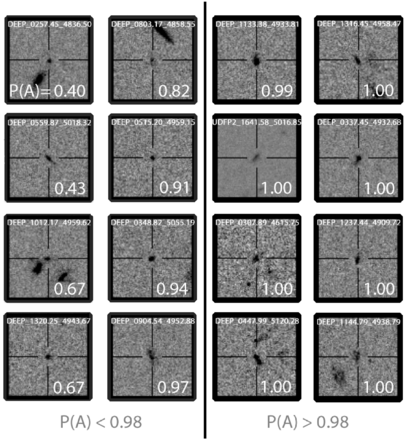We present the results of a study investigating the sizes and morphologies of redshift 4 < z < 8 galaxies in the CANDELS (Cosmic Assembly Near-infrared Deep Extragalactic Legacy Survey) GOODS-S (Great Observatories Origins Deep Survey southern field), HUDF (Hubble Ultra-Deep Field) and HUDF parallel fields. Based on non-parametric measurements and incorporating a careful treatment of measurement biases, we quantify the typical size of galaxies at each redshift as the peak of the lognormal size distribution, rather than the arithmetic mean size. Parametrizing the evolution of galaxy half-light radius as r50 ∝ (1 + z)n, we find n = −0.20 ± 0.26 at bright UV-luminosities (0.3L*(z = 3) < L < L*) and n = −0.47 ± 0.62 at faint luminosities (0.12L* < L < 0.3L*).

Postage stamps of a selection of M1500 <−20 objects in the z ∼ 4 redshift bin separated using the P(A) > 0.98 cut, where we require 98 per cent of the simulated single Sérsic profiles have asymmetry values lower than the measured asymmetry value to be able to label that object as ‘disturbed’.
Furthermore, simulations based on artificially redshifting our z ∼ 4 galaxy sample show that we cannot reject the null hypothesis of no size evolution. We show that this result is caused by a combination of the size-dependent completeness of high-redshift galaxy samples and the underestimation of the sizes of the largest galaxies at a given epoch. To explore the evolution of galaxy morphology we first compare asymmetry measurements to those from a large sample of simulated single Sérsic profiles, in order to robustly categorize galaxies as either ‘smooth’ or ‘disturbed’. Comparing the disturbed fraction amongst bright (M1500 ≤ −20) galaxies at each redshift to that obtained by artificially redshifting our z ∼ 4 galaxy sample, while carefully matching the size and UV-luminosity distributions, we find no clear evidence for evolution in galaxy morphology over the redshift interval 4 < z < 8. Therefore, based on our results, a bright (M1500 ≤ −20) galaxy at z ∼ 6 is no more likely to be measured as ‘disturbed’ than a comparable galaxy at z ∼ 4, given the current observational constraints.
The full paper can be found in Curtis-Lake et al. 2016, MNRAS, 457, 440
